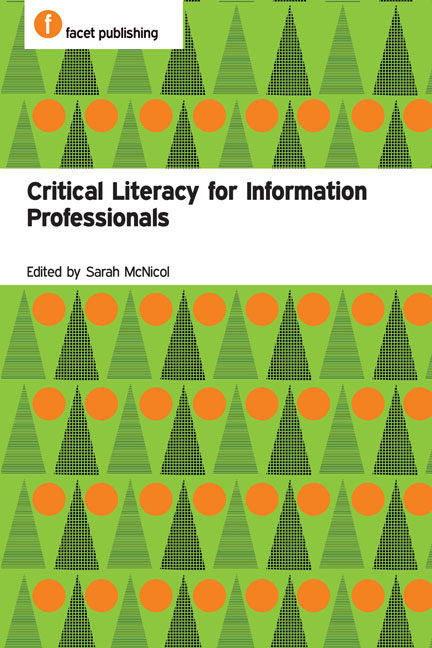Book contents
- Frontmatter
- Contents
- Contributors
- Introduction
- PART 1 THEORIES OF CRITICAL LITERACY
- 1 Renegotiating the place of fiction in libraries through critical literacy
- 2 Death of the author(ity): repositioning students as constructors of meaning in information literacy instruction
- 3 Reading health-education comics critically: challenging power relationships
- 4 Reframing librarians’ approaches to international students’ information literacy through the lens of New Literacy Studies
- 5 Using new literacies to discuss disability in the library
- 6 ‘Anyone can cook’: critical literacy in the workplace
- 7 Social justice, adult learning and critical literacy
- PART 2 CRITICAL LITERACY IN PRACTICE
- Further information
- Index
2 - Death of the author(ity): repositioning students as constructors of meaning in information literacy instruction
from PART 1 - THEORIES OF CRITICAL LITERACY
Published online by Cambridge University Press: 08 June 2018
- Frontmatter
- Contents
- Contributors
- Introduction
- PART 1 THEORIES OF CRITICAL LITERACY
- 1 Renegotiating the place of fiction in libraries through critical literacy
- 2 Death of the author(ity): repositioning students as constructors of meaning in information literacy instruction
- 3 Reading health-education comics critically: challenging power relationships
- 4 Reframing librarians’ approaches to international students’ information literacy through the lens of New Literacy Studies
- 5 Using new literacies to discuss disability in the library
- 6 ‘Anyone can cook’: critical literacy in the workplace
- 7 Social justice, adult learning and critical literacy
- PART 2 CRITICAL LITERACY IN PRACTICE
- Further information
- Index
Summary
Introduction
In ‘The Death of the Author’, Barthes (1977, 146) writes that a text is ‘a multidimensional space in which a variety of writings, none of them original, blend and clash. The text is a tissue of quotations drawn from the innumerable centres of culture’. He asserts that the meaning of a text is fluid, and open to the interpretations of the reader. Foucault (1979a) further deconstructs authorship in ‘What is an Author?’ by taking the author away from the centre of the meaning-making process and exposing the role of the reader in the construction of a text. This notion is, in many ways, counter to the traditional work of bibliographic and information literacy instruction, which is concerned almost overwhelmingly with establishing authorial intent and determining expertise. This dogged focus on ‘authorship’ results in a curriculum in which popular and scholarly sources are positioned on either side of a value-laden binary, and where the process of critical evaluation – purportedly the heart of the project of information literacy – is often an effort to discern existing meanings, rather than challenge them. This emphasis on authorship also does nothing to recognize the ways in which a reader's relationship with a text is, fundamentally, a discourse in which meaning is continually negotiated and filtered through one's own lived experiences and values.
In the spirit of Barthes and Foucault, this chapter is not solely about authors and authorship. Instead, it focuses on the conversations that arise when information literacy attempts to de-centre authorial intent and turn the lens back on the reader, or learner, as the constructor of meaning. When a learner is empowered to locate their own sense of ‘truth’ in a text, the discourse opens up into an examination of how those truths are, in themselves, constructed. To understand the importance or impact of an information source, one has to consider the audience response to a particular text and address interpretation as much as, if not more than, authorial intent. The focus I propose here is not an outright poststructuralist rejection of authorship but, rather, a recognition of the unique ways in which the field of information literacy should holistically consider its interactions with authorship.
- Type
- Chapter
- Information
- Critical Literacy for Information Professionals , pp. 19 - 30Publisher: FacetPrint publication year: 2016
- 2
- Cited by



